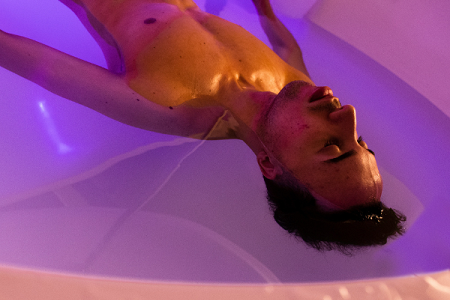John C. Lilly: The pioneer of floating
We explore the life and times of floating’s most important figure.

From January 6 1915 until his death on September 30 2001, John Cunningham Lilly pushed scientific boundaries and explored what he believed was the limitless potential of the mind.
His career spanned the worlds of physician, neuroscientist, psychoanalyst, psychonaut, philosopher, writer and inventor, at times being praised by the scientific and medical community as a pioneer and at others being ostracised by them as an eccentric.
For example, he was the first person to map pain and pleasure pathways in the brain and devised pain-free methods for introducing electrodes deep in an animal’s cortex, allowing for groundbreaking research.
Despite his eccentric methods, his work in the study of dolphins and inter-species communication encouraged a generation of scientists to study marine mammals and raised awareness and respect for the animals.
Yet it was his work in sensory deprivation that has perhaps been his greatest legacy.
In 1954 he invented the world’s first floatation tank, an enclosed saline bath designed for intensive study of human consciousness when deprived of as much external stimulus as possible.
In the original deprivation tank, you were suspended in 160 gallons [725 litres] of water with everything but the top of your head completely submerged. A nightmarish-looking “black-out” mask supplied you with air and blocked any light from reaching your eyes.
Later alterations did away with the mask and requirement of total submersion. Instead, the water was saturated with 800 pounds [360kg] of Epsom salt, making the water so dense you can float on the surface – akin to the modern set-up of i-sopod tanks we use here at Floatworks.
Rather than using the tanks to provide peace and relaxation from external pressures and distractions, Lilly’s obsession was of mind travel and exploring alternate realities.
It’s worth bearing in mind he often conducted experiments with mind-altering drugs, including ketamine and lysergic acid diethylamide, also known as LSD.
Born in the American midwest in Minnesota, Lilly’s career spanned the worlds of physician, neuroscientist, psychoanalyst, psychonaut, philosopher, writer and inventor.
He showed an early aptitude for the sciences, conducting chemistry experiments in his basement by 13 and being christened Einstein Jr by his fellow students at his Catholic grade school.
He went on to study physics and biology at the California Institute of Technology, followed by a medical degree from the University of Pennsylvania in 1942, and continuing to study biophysics and psychoanalysis.
In World War II, he researched the physiology of high-altitude flying and invented instruments for measuring gas pressure before switching his focus to probing the physical structures of the brain.
In 1954, while working at the Public Health Service Commissioned Officers Corps, he began experimenting with an isolation tank, using himself and another scientist as the first subjects, suspended for hours in warm salt water.
In his 1972 book The Center of the Cyclone, he described the first time he used LSD in an isolation tank: “I traveled through my brain, watching the neurons and their activities”.
He turned his attention to dolphins in the late 1950s, when he established the Communication Research Institute on St. Thomas in the Virgin Islands, a centre devoted to fostering human-dolphin communication. Here, in 1965, Lilly conducted his most notorious and highly criticised experiment.
For ten weeks his young assistant, Margaret Howe, volunteered to live in confinement with Peter, a bottlenose dolphin, in a house flooded with water, allowing them both to live, sleep, eat, wash and play intimately together. The objective of the experiment was to see whether a dolphin could be taught human speech and became the focus of a 2014 documentary The Girl Who Talked To Dolphins.
His work inspired two movies, 1973’s Day Of The Dolphin, in which the Navy turns the animals into weapons, and 1980’s Altered States, in which scientists combining drugs and isolation tanks see reality dangerously unravel.
More recently the influence of his work in the fields of floatation and sensory deprivation can be seen on the small screen, in both Fox’s supernatural drama series Fringe (2008-13) and Netflix’s hugely popular sci-fi horror show Stranger Things.
Despite his acclaim within the worlds of fantasy and pop culture, Lilly’s most emphatic legacy was through his work with float tanks; which has allowed millions of people to calm the mind and body, and bring positive changes to the lives of so many.
Lilly died at the age of 86 in Los Angeles due to heart failure. A decade previously in 1991, Mavericks of the Mind Author David Jay Brown interviewed him at his home in Malibu. “It was a magically enchanting evening,” Brown wrote.
“John was like a Zen master, with sparkling extraterrestrial eyes, in top form, more brilliant than ever at 76, laughing, creating and bursting realities like soap bubbles. John is very direct and ruthlessly compassionate, more knowledgeable than a library of encyclopedias yet as innocent and curious as a small child.”
On the home page of his site, johnclilly.com, maintained by the John C. Lilly Institute, it reads, “In the province of the mind, there are no limits.”
Have you begun a journey of self-discovery? Check out our latest floating offers to find out firsthand how floating will help you become more mindful…










